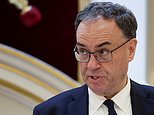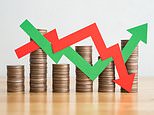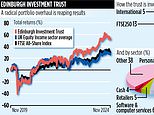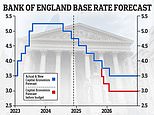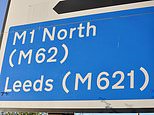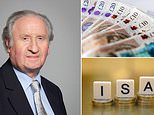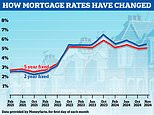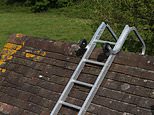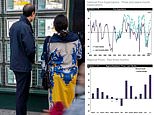EXCLUSIVEI was the first Isa millionaire... Lord Lee's three-step blueprint to follow in his footsteps
Britain's most dedicated Isa investors have racked up pots worth almost £9million each.
Yes, you've read that correctly... there are 25 super Isa investors in the country who have an average of £8.9million saved in their tax-free accounts.
It comes as the number of Isa millionaires soared 228 per cent in two years, with nearly 5,000 savvy investors now in that club.
One of them, Lord John Lee of Trafford, became the first Isa millionaire in 2003.
He tells This is Money the value of his Isas is now 'well north of that first million and has grown very significantly...' although stopped short of revealing whether he was one of the 25 super Isa holders.
He reached the seven-figure milestone on contributions of £126,200 made over 16 years.
His annualised returns during this period were 21 per cent. Since 2003, Lord Lee estimates he has made around £150,000 of additional Isa contributions.
Below, he reveals his three top tips to joining the millionaire Isa club.

Lord John Lee of Trafford led the charge by becoming the first Isa millionaire in 2003. Today there are 4,850 Isa millionaires
1. Max out your Isa allowance
A fortune this big could only be gained through investing in stocks and shares and the first step to becoming an Isa millionaire is maxing out your Isa every year.
This might be a struggle for most savers now that the Isa limit is £20,000, where it was raised to in 2017 from £15.240.
Figures from HMRC show that only 4 per cent of Isa savers max out their Isa. But those who are able to achieve this will be well on the road to becoming an Isa millionaire.
'I've been investing since 1987', said Lord Lee, 'those who started early like me had an advantage.'
Isas were introduced in 1999, replacing their predecessor Personal Equity Plans (Peps) which were launched in 1987 by then chancellor Nigel Lawson.
Peps investors were allowed to lump their money into Isas as they were merged on 6 April 1999, so together that is 37 years of allowances to max out.
There were two annual Pep allowances each year, a General Pep (which ended up at £6,000 and from 1991 an additional Single Company Pep of £3,000 (which could only be invested in an individual UK company share).
Together the Pep allowances were £9,000 (higher than the initial £7,000 Isa allowance).
Jason Hollands, a director of stockbroker Best Invest said: 'If you assume someone invested in every Pep and Isa allowance on a lump sum basis at the start of the tax year since the inception of Peps in 1987 then you would have needed to achieve a compound annual growth rate of 13.55 per cent to accumulate £8.9million.'
Given that Lord Lee had 21 per cent growth between 1987 and 2003, it's easy to see how it could quite possibly be in that top 25 list of super savers.
| Tax year beginning 6 April | Isa allowance |
|---|---|
| 1999/00 | £7,000 |
| 2000/01 | £7,000 |
| 2001/02 | £7,000 |
| 2002/03 | £7,000 |
| 2003/04 | £7,000 |
| 2004/05 | £7.000 |
| 2005/06 | £7,000 |
| 2006/07 | £7,000 |
| 2007/08 | £7,000 |
| 2008/09 | £7,200 |
| 2009/10 | £10,200 |
| 2010/11 | £10,200 |
| 2011/12 | £10,680 |
| 2012/13 | £11,280 |
| 2013/14 | £11,520 |
| 2014/15 | £11,880 |
| 2015/16 | £15,240 |
| 2016/17 | £15,240 |
| 2017/18 | £20,000 |
| 2018/19 | £20,000 |
| 2019/20 | £20,000 |
| 2020/21 | £20,000 |
| 2021/22 | £20,000 |
| 2022/23 | £20,000 |
| 2023/24 | £20,000 |
| 2024/25 | £20,000 |
2: Reinvest dividends
When it comes to generating long-term investment returns, compounding – through the automatic reinvesting of dividends – can be a powerful tool.
By reinvesting dividends, you reinvest the cash you would have been paid out as a dividend to buy extra shares in the company rather than receiving the dividend as cash to your bank account.
And that has been one of Lord Lee's key tactics.
If someone bought £1,000 worth of shares in a company paying a 3 per cent annual dividend yield and reinvest the dividends every year for a decade, in year one, they would earn £30 and their investment would grow to £1,030.
The following year they would earn £30.90, increasing their investment to £1,060.9.
After ten years, the original investment would be worth £1,343.92 – and that's before any rise in the share price.
If the share price also rises, this would have an even greater impact on the investment because you benefit from both investment growth and dividend growth.
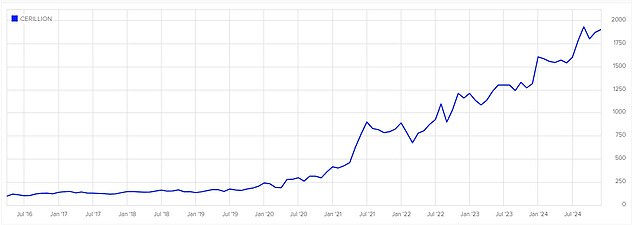
Share price of telecoms company Cerillion, which Lord Lee invested in on the first day it listed on the stock exchange in 2016
3. Be lucky in your investments
This step may be slightly more down to fate, but one thing these Isa millionaires have in common is that they have made some very astute – or possibly lucky – investments over the years.
It's unlikely that Isa savers with pots amounting to almost £9million have been investing in index trackers over the years. It is instead more likely that they had some serious successes on the way and gains were locked-in, perhaps from individual shares.
Investing at the right time would also have been a factor in building their Isa fortunes. Some may have done well from periods like the dot com bubble, making sure they jumped off before it burst.
'You would have needed two or three really successful investments to build up an Isa pot averaging £8.9million and to be lucky with them,' Lord Lee said.
As an example, Lord Lee invested in Cerillion, a telecoms company, when it was first listed on the stock exchange in 2016.
Its share price on 18 March 2016 on its first day of dealing was 98p while today, it has risen to 1,935p.
Lord Lee has also been on the receiving end of some 60 takeover bids for companies he holds, which has given his investments a boost.
Hollands said: 'An annualised compound annualised growth rate of 13.55 per cent is high to achieve consistently. In reality, markets returns vary wildly year to year. There are also possibly a few very shrewd or lucky stock calls that may have driven returns.
'Nevertheless, it does demonstrate the power of consistent investing over time and the wonders of compound growth which Einstein describe as the 'eighth wonder of the world.'
SAVE MONEY, MAKE MONEY
Affiliate links: If you take out a product This is Money may earn a commission. These deals are chosen by our editorial team, as we think they are worth highlighting. This does not affect our editorial independence. *Chase: Cashback available for first year. Exceptions apply. 18+, UK residents.






